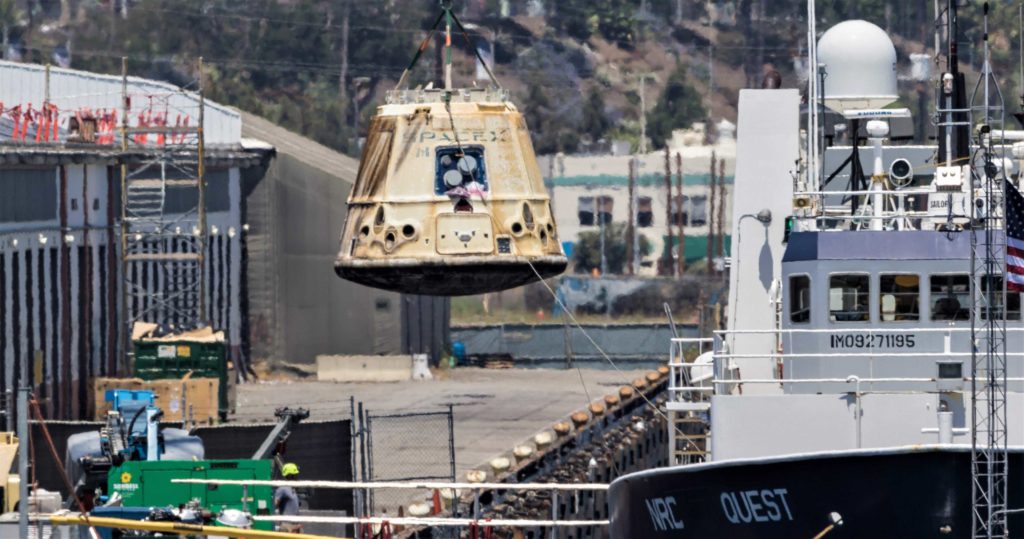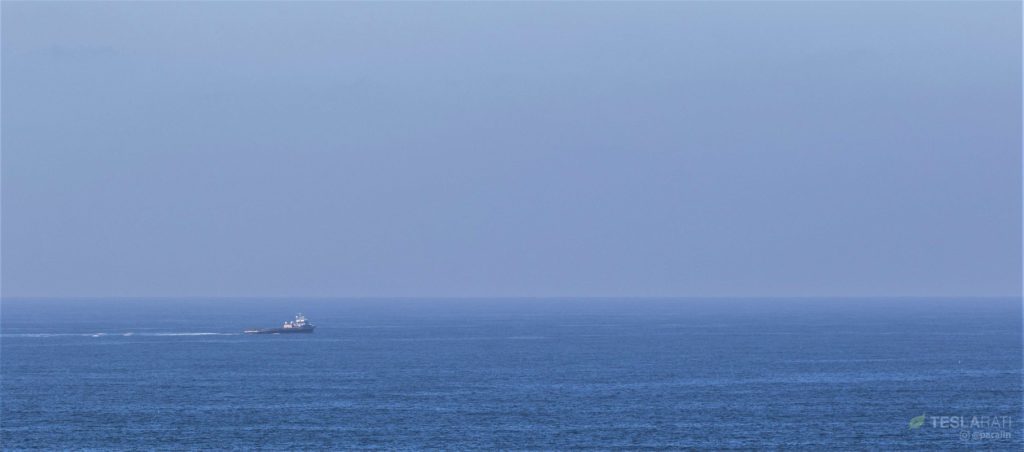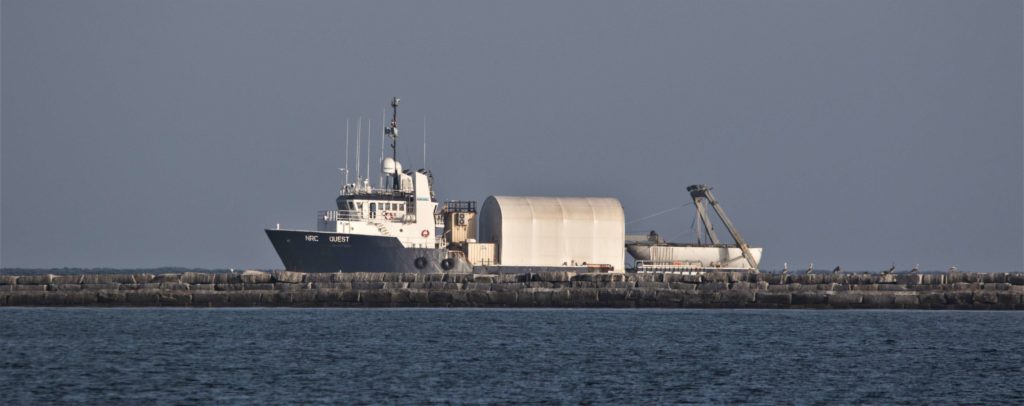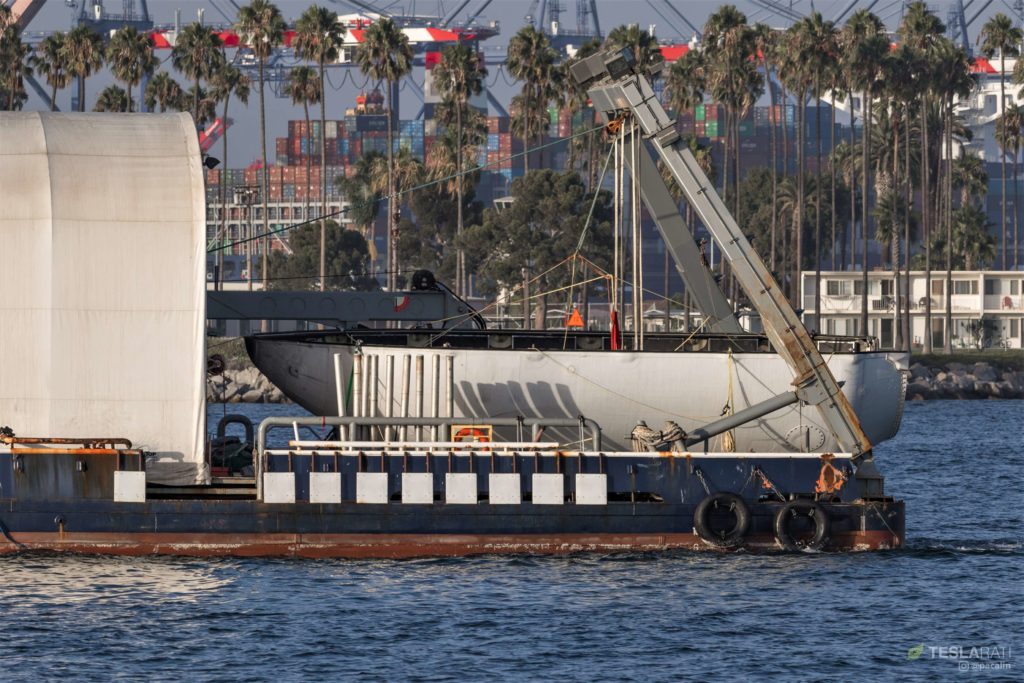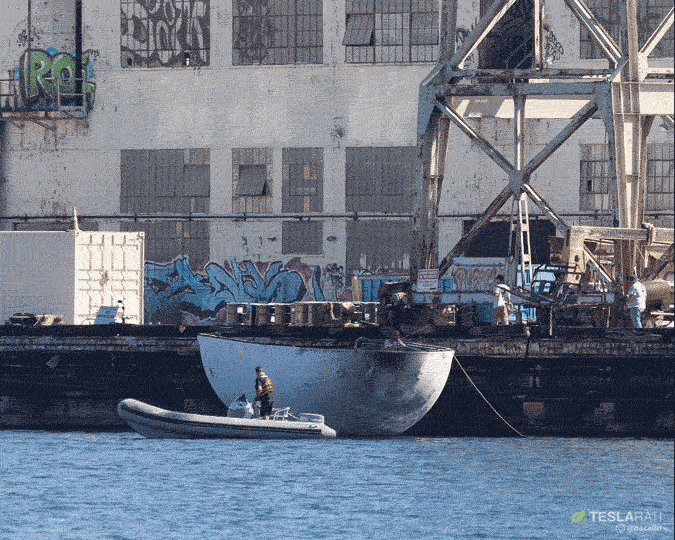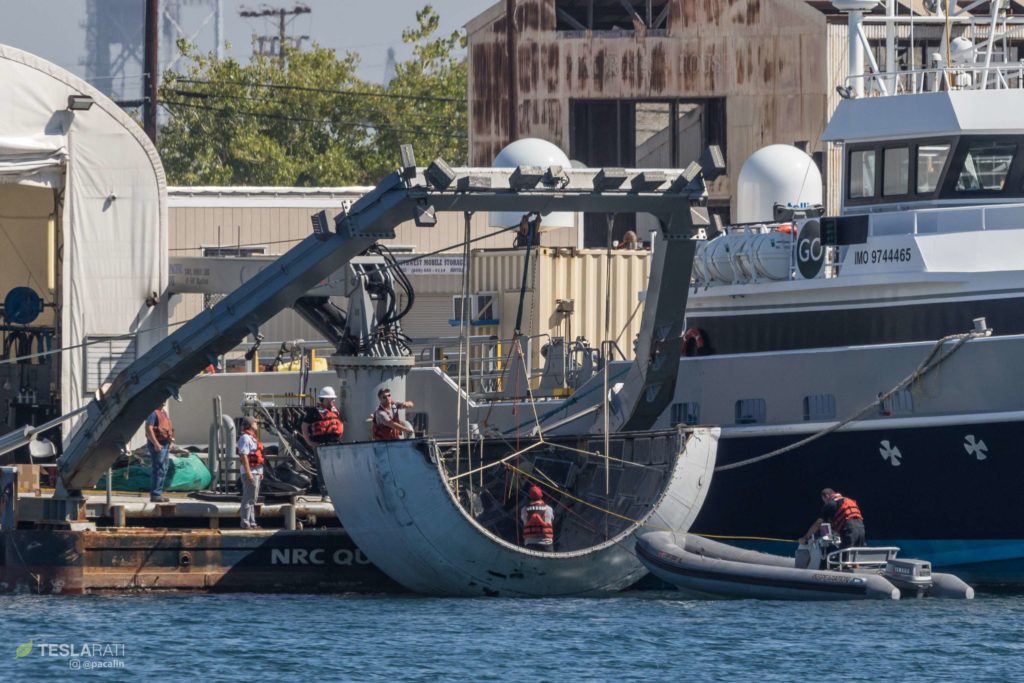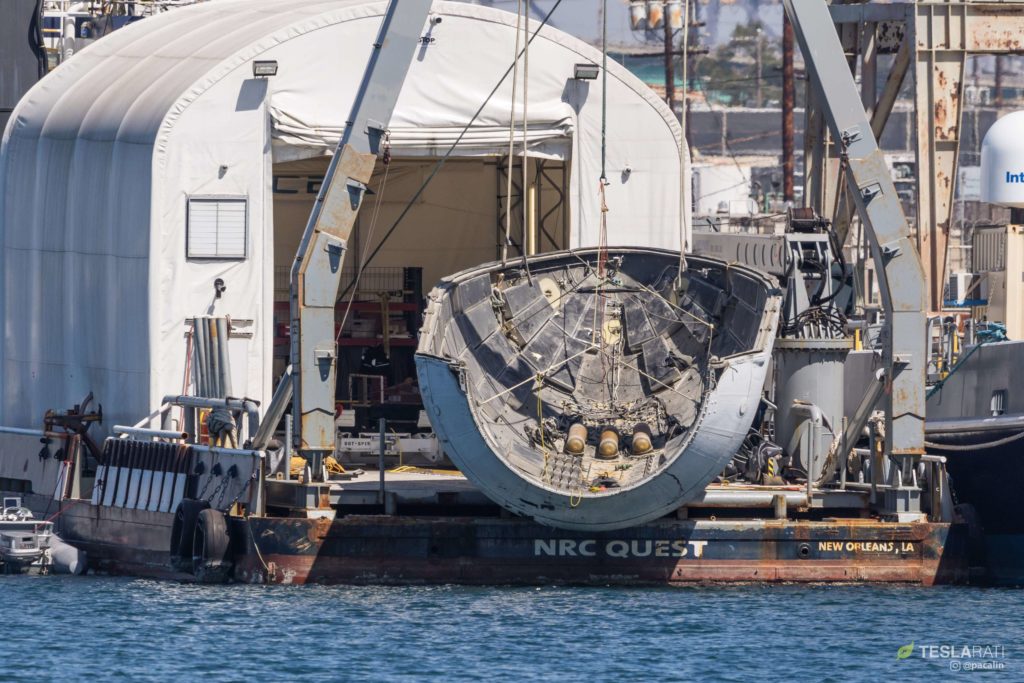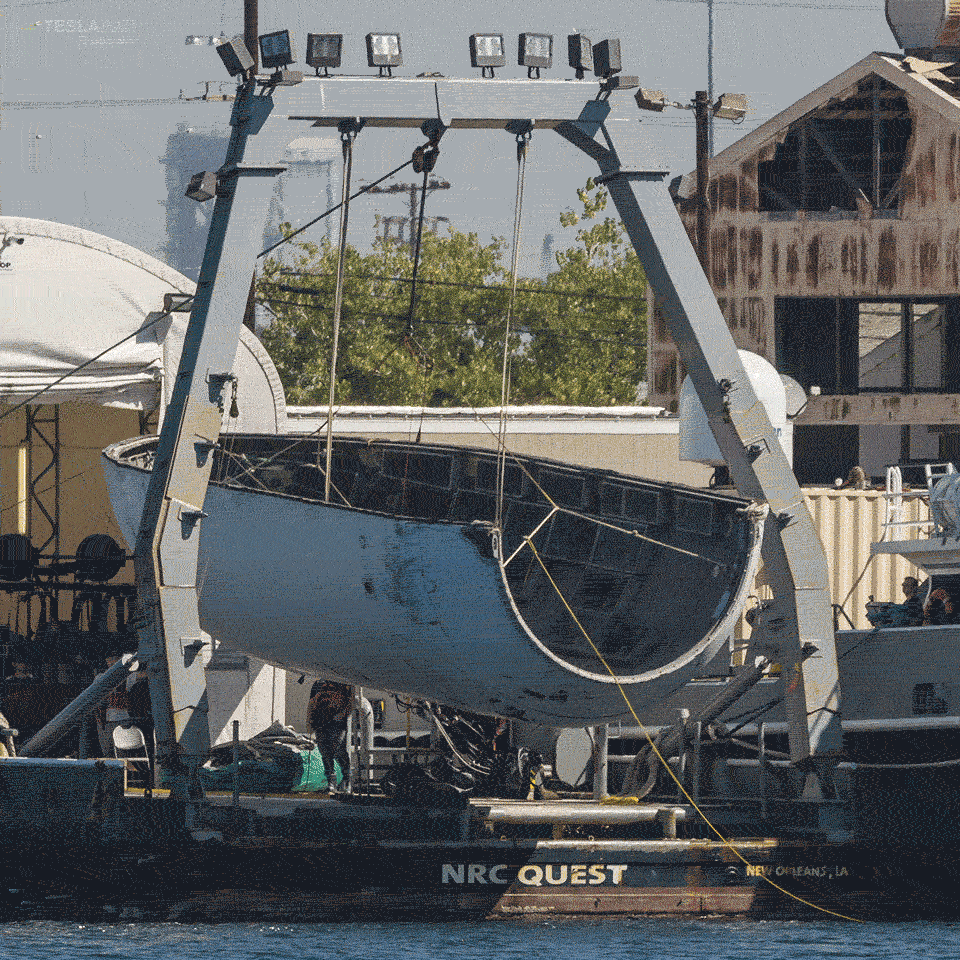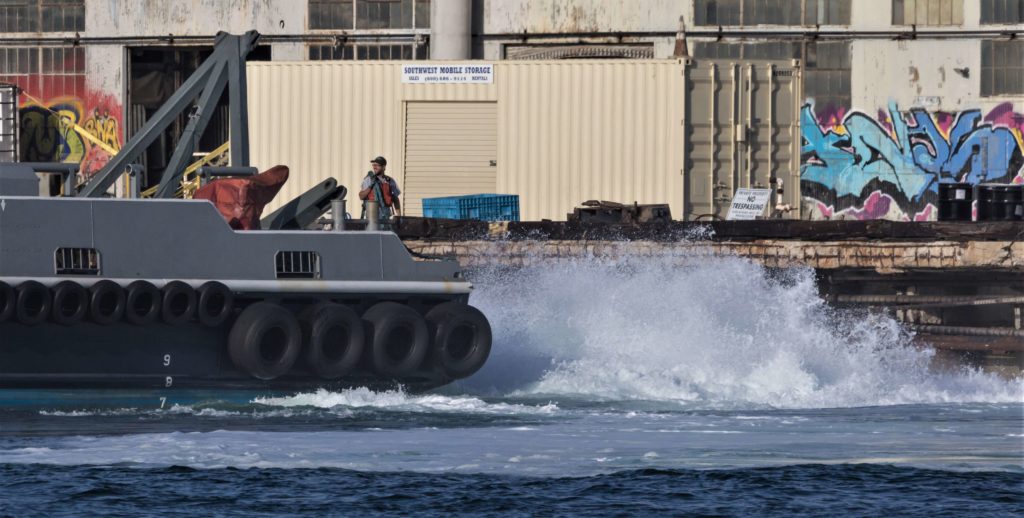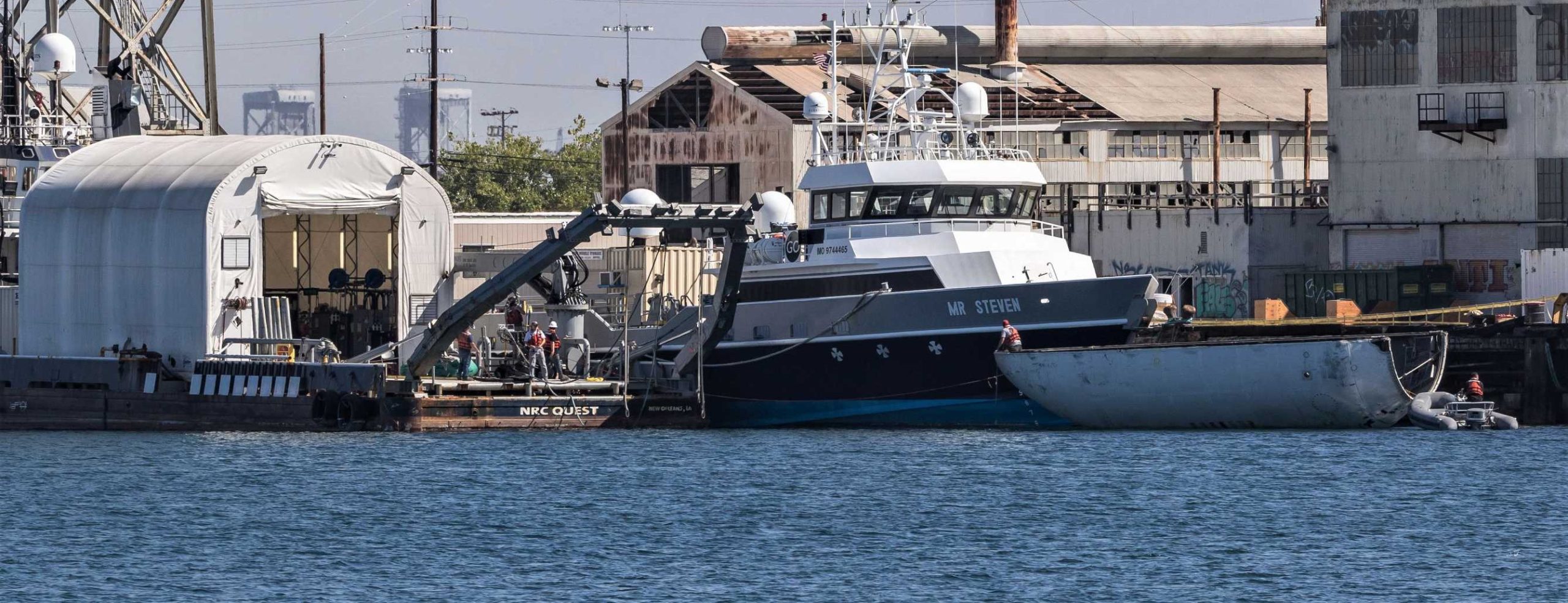
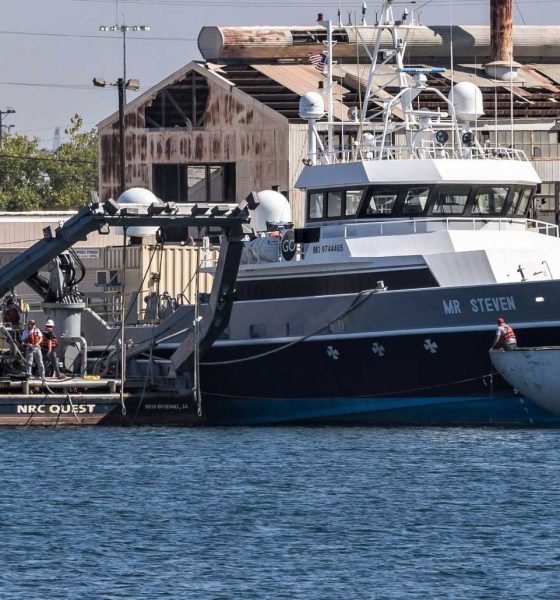
News
SpaceX techs work towards Falcon 9 fairing recovery with wacky series of experiments
Over the course of the past week, Teslarati photographer Pauline Acalin has captured a multitude of unusual occurrences at SpaceX’s Port of Los Angeles dock space, each time involving a Falcon fairing recovery vessel like Mr Steven or NRC Quest, a Falcon fairing half (flight-proven or otherwise), and one of several attenuating circumstances.
More likely than not, what appears as a menagerie of weird and disconnected events on the sidelines is actually a reasonably organized leg of a larger program, in this case focused on experimentation and testing to close the fairing recovery loop and secure Mr Steven’s first successful fairing catch.
From @USCGLosAngeles – A captive carry test involving a helicopter picking an item from a vessel will be conducted 9/20, 11-1300, in the vicinity of San Clemente Island in the San Nicolas Basin. Mariners are requested to maintain a distance of 5NM from the operation. pic.twitter.com/nvy6Wo0IvF
— Marine Exchange (@MXSOCAL) September 19, 2018
The mystery of Catalina Island
Now-iconic fairing recovery vessel (or net-boat, or claw-boat) Mr Steven has been out of commission since late August, at which point SpaceX technicians removed all four of his arms and their eight complementary shock absorber booms towards unknown ends. If SpaceX’s past is any judge, those arms are probably in the process of being upgraded, but it’s impossible to judge thanks to the fact that they have simply disappeared from the Berth 240 docks where they were briefly stored. SpaceX certainly has a way with transporting massive, ungainly objects without stirring a whisper.
Despite lacking arms for more than a month, Mr Steven has still performed a number of sea-trials, ranging from average jaunts a few miles away to a mysterious armless test described in the tweet above. Why exactly Mr Steven was involved in an experiment involving a helicopter “picking an item” – in this case a flight-proven Falcon fairing – off of a vessel while entirely lacking the arms and net he would use to catch said fairing is entirely unclear. Perhaps it was meant to test a datalink or a change to fairing recovery hardware. Whatever transpired, a group of SpaceX technicians certainly flew to Catalina Island and were working alongside or with a Blackhawk helicopter capable of externally carrying up to 3600 kg (8000 lb) of cargo.
- Shortly after completing the CRS-15 resupply mission, Cargo Dragon C110 is craned from NRC Quest to SpaceX’s Port of San Pedro berth, 08/05/18. (Pauline Acalin)
- Mr Steven was out and about conducting high-speed maneuvers two days prior, and also joined NRC Quest near Catalina Island on the 20th. (Pauline Acalin)
- NRC Quest returned to port with a Falcon fairing aboard after a long day doing *something* at sea. (Pauline Acalin)
- Note the sooty tip of the fairing’s nose, a telltale sign that it previously flew on a Falcon 9 launch. (Pauline Acalin)
Multipurpose recovery vessel NRC Quest – nominally dedicated to Cargo Dragon spacecraft recoveries – returned to SpaceX-leased Berth 240 a few hours after the September 20th test window closed, sooty Falcon 9 fairing half in tow. Still, this certainly isn’t the weirdest Falcon fairing-related activity to occur last week.
Fairings aplenty
Meanwhile, over at Mr Steven’s old berth and drone ship Just Read The Instructions’ current berth, a different Falcon fairing half appeared sometime in the last several days in an unusual state, seemingly either fresh out of the factory or in an advanced state of disassembly. The base of this particular fairing half seems to be entirely missing the usual layer(s) of material (cork, among other things) used to waterproof and act as a lightweight heatshield. A new fairing half sitting out in the elements with zero protection would be exceptionally unusual, as CEO Elon Musk has noted that they each cost several million dollars ($3m to be precise), and exposure outside of a cleanroom could very well prevent this half from ever being operationally flown.

The next best conclusion to be drawn is that this unique fairing half is new or flight-proven (with skin and shielding removed), but sitting at SpaceX’s dock space in order to prepare for one or several active drop tests in pursuit of Mr Steven’s first successful fairing catch. But who really knows, to be honest. The fairing’s bare carbon fiber composite construction is certainly a sight to behold, one way or another.
Doing…something.
This leads us to the grand (perhaps… titanic) finale of wholly unexpected Falcon fairing activities over the last several days. Presumably making the best of an opportunity to test NRC Quest’s ability to recover Falcon fairings after splashdown (i.e. missing Mr Steven’s net), the pictures generally tell the story better than any words ever could. Keep your eyes peeled for Fairing Wrangler job openings.
- Getting the (un)lucky half into the water. (Pauline Acalin)
- One lucky dude. (Pauline Acalin)
- Weeeeeeeeee. (Pauline Acalin)
- NRC Quest then lifted the fairing half (likely from Iridium-7) aboard. (Pauline Acalin)
- NRC Quest then lifted the fairing half (likely from Iridium-7) aboard. (Pauline Acalin)
- This extraordinarily unusual operation lent an opportunity to see just how flexible and structurally optimized SpaceX’s payload fairings are. (Pauline Acalin)
- After returning from a day at sea doing who-knows-what, Mr Steven’s captain attempted to use the 500 metric ton vessel to splash a fellow recovery tech. A for effort. (Pauline Acalin)
Up next for SpaceX, Mr Steven, and the West Coast recovery crew is SAOCOM-1A, scheduled to launch from California’s Vandenberg Air Force Base on the evening (Pacific Time) of October 6th.
For prompt updates, on-the-ground perspectives, and unique glimpses of SpaceX’s rocket recovery fleet check out our brand new LaunchPad and LandingZone newsletters!

Elon Musk
Elon Musk’s X will start using a Tesla-like software update strategy
The initiative seems designed to accelerate updates to the social media platform, while maintaining maximum transparency.

Elon Musk’s social media platform X will adopt a Tesla-esque approach to software updates for its algorithm.
The initiative seems designed to accelerate updates to the social media platform, while maintaining maximum transparency.
X’s updates to its updates
As per Musk in a post on X, the social media company will be making a new algorithm to determine what organic and advertising posts are recommended to users. These updates would then be repeated every four weeks.
“We will make the new 𝕏 algorithm, including all code used to determine what organic and advertising posts are recommended to users, open source in 7 days. This will be repeated every 4 weeks, with comprehensive developer notes, to help you understand what changed,” Musk wrote in his post.
The initiative somewhat mirrors Tesla’s over-the-air update model, where vehicle software is regularly refined and pushed to users with detailed release notes. This should allow users to better understand the details of X’s every update and foster a healthy feedback loop for the social media platform.
xAI and X
X, formerly Twitter, has been acquired by Elon Musk’s artificial intelligence startup, xAI last year. Since then, xAI has seen a rapid rise in valuation. Following the company’s the company’s upsized $20 billion Series E funding round, estimates now suggest that xAI is worth tens about $230 to $235 billion. That’s several times larger than Tesla when Elon Musk received his controversial 2018 CEO Performance Award.
As per xAI, the Series E funding round attracted a diverse group of investors, including Valor Equity Partners, Stepstone Group, Fidelity Management & Research Company, Qatar Investment Authority, MGX, and Baron Capital Group, among others. Strategic partners NVIDIA and Cisco Investments also continued support for building the world’s largest GPU clusters.
News
Tesla FSD Supervised wins MotorTrend’s Best Driver Assistance Award
The decision marks a notable reversal for the publication from prior years, with judges citing major real-world improvements that pushed Tesla’s latest FSD software ahead of every competing ADAS system.

Tesla’s Full Self-Driving (Supervised) system has been named the best driver-assistance technology on the market, earning top honors at the 2026 MotorTrend Best Tech Awards.
The decision marks a notable reversal for the publication from prior years, with judges citing major real-world improvements that pushed Tesla’s latest FSD software ahead of every competing ADAS system. And it wasn’t even close.
MotorTrend reverses course
MotorTrend awarded Tesla FSD (Supervised) its 2026 Best Tech Driver Assistance title after extensive testing of the latest v14 software. The publication acknowledged that it had previously criticized earlier versions of FSD for erratic behavior and near-miss incidents, ultimately favoring rivals such as GM’s Super Cruise in earlier evaluations.
According to MotorTrend, the newest iteration of FSD resolved many of those shortcomings. Testers said v14 showed far smoother behavior in complex urban scenarios, including unprotected left turns, traffic circles, emergency vehicles, and dense city streets. While the system still requires constant driver supervision, judges concluded that no other advanced driver-assistance system currently matches its breadth of capability.
Unlike rival systems that rely on combinations of cameras, radar, lidar, and mapped highways, Tesla’s FSD operates using a camera-only approach and is capable of driving on city streets, rural roads, and freeways. MotorTrend stated that pure utility, the ability to handle nearly all road types, ultimately separated FSD from competitors like Ford BlueCruise, GM Super Cruise, and BMW’s Highway Assistant.
High cost and high capability
MotorTrend also addressed FSD’s pricing, which remains significantly higher than rival systems. Tesla currently charges $8,000 for a one-time purchase or $99 per month for a subscription, compared with far lower upfront and subscription costs from other automakers. The publication noted that the premium is justified given FSD’s unmatched scope and continuous software evolution.
Safety remained a central focus of the evaluation. While testers reported collision-free operation over thousands of miles, they noted ongoing concerns around FSD’s configurable driving modes, including options that allow aggressive driving and speeds beyond posted limits. MotorTrend emphasized that, like all Level 2 systems, FSD still depends on a fully attentive human driver at all times.
Despite those caveats, the publication concluded that Tesla’s rapid software progress fundamentally reshaped the competitive landscape. For drivers seeking the most capable hands-on driver-assistance system available today, MotorTrend concluded Tesla FSD (Supervised) now stands alone at the top.
News
Elon Musk’s Grokipedia surges to 5.6M articles, almost 79% of English Wikipedia
The explosive growth marks a major milestone for the AI-powered online encyclopedia, which was launched by Elon Musk’s xAI just months ago.

Elon Musk’s Grokipedia has grown to an impressive 5,615,201 articles as of today, closing in on 79% of the English Wikipedia’s current total of 7,119,376 articles.
The explosive growth marks a major milestone for the AI-powered online encyclopedia, which was launched by Elon Musk’s xAI just months ago. Needless to say, it would only be a matter of time before Grokipedia exceeds English Wikipedia in sheer volume.
Grokipedia’s rapid growth
xAI’s vision for Grokipedia emphasizes neutrality, while Grok’s reasoning capabilities allow for fast drafting and fact-checking. When Elon Musk announced the initiative in late September 2025, he noted that Grokipedia would be an improvement to Wikipedia because it would be designed to avoid bias.
At the time, Musk noted that Grokipedia “is a necessary step towards the xAI goal of understanding the Universe.”
Grokipedia was launched in late October, and while xAI was careful to list it only as Version 0.1 at the time, the online encyclopedia immediately earned praise. Wikipedia co-founder Larry Sanger highlighted the project’s innovative approach, noting how it leverages AI to fill knowledge gaps and enable rapid updates. Netizens also observed how Grokipedia tends to present articles in a more objective manner compared to Wikipedia, which is edited by humans.
Elon Musk’s ambitious plans
With 5,615,201 total articles, Grokipedia has now grown to almost 79% of English Wikipedia’s article base. This is incredibly quick, though Grokipedia remains text-only for now. xAI, for its part, has now updated the online encyclopedia’s iteration to v0.2.
Elon Musk has shared bold ideas for Grokipedia, including sending a record of the entire knowledge base to space as part of xAI’s mission to preserve and expand human understanding. At some point, Musk stated that Grokipedia will be renamed to Encyclopedia Galactica, and it will be sent to the cosmos.
“When Grokipedia is good enough (long way to go), we will change the name to Encyclopedia Galactica. It will be an open source distillation of all knowledge, including audio, images and video. Join xAI to help build the sci-fi version of the Library of Alexandria!” Musk wrote, adding in a later post that “Copies will be etched in stone and sent to the Moon, Mars and beyond. This time, it will not be lost.”
